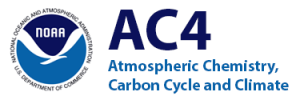- Year Funded: 2016
- Principal Investigators: Daven Henze, Associate Professor, Environmental Engineering Program, University of Colorado
- Programs: AC4 Funded Project
- FIREX
- Google Scholar Link
Open biomass burning (including agriculture fires, wildfires, and managed fires) is one of the largest contributors to aerosols and trace gases, and its emissions have a significant influence on air quality, weather, and climate at the local, regional, and global scales. Nevertheless, several challenges have been identified regarding the characterization of these impacts. We thus propose to participate in the FIREX field experiment and complementary research activities to study the following science questions:
- What are the size distributions and absorptive properties of aerosol emissions from different biomass fuels, and how do these climate-relevant properties evolve to impact actinic flux both directly and via interactions with clouds and other meteorological factors?
- What is the diurnal and nocturnal magnitude and spatiotemporal variability of aerosol and trace-gas emissions from different types of biomass burning?
- How can airborne measurements be optimally deployed to address the above questions, given existing observation networks (ground based and satellite), and to what extent do different data sources and inversion techniques reduce uncertainties in smoke emissions estimates?
- What are the broader impacts of fires on air quality and climate, compared to anthropogenic sources, and how do constraints from FIREX refine these estimates?
These questions will be addressed using new advances in on-line, coupled atmospheric chemistry/meteorological models, and inverse modeling techniques applicable to such coupled models, using current and evolving observation systems to improve: 1) estimates of climate relevant properties (size, absorption) of aerosols from biomass burning; 2) four-dimensional aerosol distributions (from all sources) at regional scales; and 3) estimates of the attribution of impacts to the atmospheric environment due to biomass burning as well as other specific sources. Prior to the field campaign, our team will develop and distribute essential and novel emissions inventories containing wavelength dependent light absorption properties of primary organic aerosols emitted from various fuel-type and combustion sources, size-resolved emissions factors for primary burning aerosols, and updates to anthropogenic emissions of aerosols and trace gases. These emissions, and associated model updates, will be evaluated through comparisons to measurements from additional field campaigns. During the FIREX field campaign, we will provide forecasting tools for flight planning using in-field emissions inversions and modeling experiments to determine which flight tracks would yield the greatest constraints for emissions inversions. In post-mission analysis additional techniques to constrain biomass burning emissions and carbon/nitrogen budgets will be undertaken, including application of satellite products (e.g., from CrIS and TROPOMI), analysis of co-emitted species (e.g., CO, NOX, NH3), and alternative bottom-up and top-down approaches to quantifying fires and their emissions.


